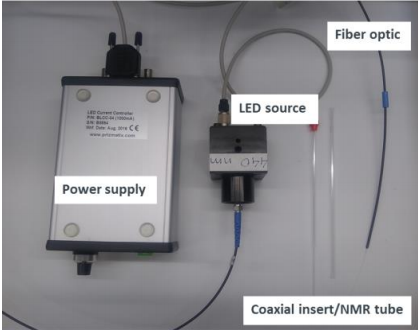Goldstone Scientific Blog
Bilateral and Unilateral Fiberoptics for Head-Fixed and Non-Moving Animals
Posted by Nathaniel Sperka on 20th Dec 2022
The Prizmatix Optogenetics LED systems shown on our webstore are configured for moving animals. Many researchers use head-fixed, anesthetized, or other nonmoving animals and wonder what the set up should look like.
How to configure Bilateral fiberoptics without a rotary joint
Many customers want to deliver light bilaterally and wonder if they can connect the Y shaped fiber directly to the Optogenetics-LED and skip the rotary joint.
The answer is “No”, this may not be done.
Why? The connector of the Y shaped fiber has a lot of epoxy filling up the dead space around the two fibers. If the fiber would be attached directly to the LED, the epoxy would melt and damage the fiberoptic and the LED. It is necessary to have a wide core mediating fiber between the LED and the Y shaped bundle. The wide core fiber delivers the light to the two branches.
But not to worry. You don’t need to buy a rotary joint. A FC-FCstationary mating connector can be used instead of the rotary joint. This will reduce the cost of the fiber assembly significantly.
The parts needed are:
Note: When using the FC-LED series which has lower power than our Optogenetics-LED, the Y shaped fiber can be connected directly to the LED without a mediating fiber. In that case, Prizmatix can make a custom fiberoptic with an SMA connector.
How to configure Unilateral fiberoptics without a rotary joint
When the animal won’t be moving and the stimulation is needed in only one implanted fiber, the fiber optics can go directly from the LED to the animal. But the usual “RJ to animal” fiber can not be used. Those fibers have an FC connector, and the LED has an SMA connector. So, the fiber needs a SMA connector on the LED side and a 1.25 or 2.5mm ferrule on the animal side. This special fiber available on the webstore here.
Please contact us if you have any question about how to configure your fiber optics.
How to make your own fiberoptic implants for Optogenetics
Goldstone Scientific offers the supplies you need to prepare your own fiber optic implants (“cannulae”) for In-Vivo Optogenetic experiments. Prizmatix created this step-by-step video tutorial which shows you how to do it. Written Instructions can be seen at: https://www.prizmatix.com/pdf/optogenetics/DIY_Cannula_Instructions.pdf The products used in the video are: DIY Kits, includes almost everything to get started including epoxy. Does not include magnifier.Raw Fiber Empty FerrulesAdditional supplies [...]
Collimation and Divergence, in Fiber Optics and Collimated LEDs
Collimating the light of an optical fiber or LED is crucial for efficient light delivery and also improves the uniformity of the light when it hits the target. In a previous blog post we discussed the importance of matching the numerical aperture (NA) of a collimating lens to the NA of the optical fiber. [...]

Popular Configurations - Fiber Coupled LED for In Situ NMR Spectroscopy - Updated March 2025
NOTE: Scroll down to see the March 2025 update section with new options One application that is gaining popularity is a fiber coupled LED for NMR Spectroscopy. The set up that most people ask for is a Mic-LED and controller with fiber coupler adapter and a long plastic fiber optic. This set up can be seen in [...]
High NA Fiber Optics for In-Vivo Optogenetics – The Options on Goldstone Scientific
Quality fiber optic implants are crucial for successful in-vivo Optogenetics. Scientists will need to spend time or money (or both) to ensure quality results. Prizmatix offers a range of options and Goldstone Scientific makes it easy to order and offers competitive prices with bulk discounts and fast shipping to save you both. Many items are [...]

High NA Fiber Optics and Collimators; Don’t Shoot Yourself in the Foot
A customer recently complained that the power output of her Prizmatix fiber coupled LED was too low. The LED system was 5 years old and she suspected that the power loss was due to age. She wrote: I'm using a Prizmatix FC8-LED fiber coupled multi-channel LED source, along with a fiber that we purchased from you. This fiber is attached to a custom-made [...]

Prizmatix Fiber Optic Rotary Joint; Compatibility of with Lasers or other light sources
The Prizmatix Fiber Optic Rotary Joint is an important part of the Prizmatix In-Vivo Optognetics Toolbox. It’s extremely low torque (<10μNm) allows even the smallest animals to move freely and its high transmission is helpful in getting as much power as possible to the target. One really nice feature of the Prizmatix fiber optic rotary joint is that it can be used [...]

In-Line Filters and Prizmatix Fiber Coupled LEDs
A customer just ask me about an in-line filter holder for the fiber coupled Prizmatix Silver-LED. He had a model chosen from another vendor. I offered him two possible alternatives. Option One – Save Money Make an in-line filter with two Prizmatix fiber coupling adapters back to back with a short SM1 tube and an internal thread between them to hold a [...]

Extra Long, Flexible Fiber-Optic Implants for Optogenetic Stimulation of Peripheral Nerves
While at SfN 2015 in Chicago quite a few people that stopped by the Prizmatix booth asked how they could optically stimulate neurons in parts of the body far from the brain. One researcher explained that due to the NIH’s SPARC program, there is an increased interest in researching peripheral nerves. Their plan was to implant a ferrule in [...]
Tissue Heating During Optogenetic Experiments Using Laser and LEDs
During a recent LinkedIn conversation regarding light sources for Optogenetics a concern was raised about LEDs causing heating of the tissue. The concern was based on information in a paper “Optogenetics in Neural Systems” published by O Yizhar et al., Neuron, 2011. A careful reading of this paper shows that the concern is relevant only to small LEDs implanted in the tissue, [...]
